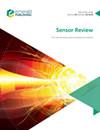Fiber-optic-based force and shape sensing in surgical robots: a review
IF 1.4
4区 工程技术
Q3 INSTRUMENTS & INSTRUMENTATION
引用次数: 2
Abstract
Purpose With the increasing development of the surgical robots, the opto-mechatronic technologies are more potential in the robotics system optimization. The optic signal plays an important role in opto-mechatronic systems. This paper aims to present a review of the research status on fiber-optic-based force and shape sensors in surgical robots. Design/methodology/approach Advances of fiber-optic-based force and shape sensing techniques in the past 20 years are investigated and summarized according to different surgical requirement and technical characteristics. The research status analysis and development prospects are discussed. Findings Compared with traditional electrical signal conduction, the phototransduction provides higher speed transmission, lower signal loss and the immunity to electromagnetic interference in robot perception. Most importantly, more and more advanced optic-based sensing technologies are applied to medical robots in the past two decades because the prominence is magnetic resonance imaging compatibility. For medical robots especially, fiber-optic sensing technologies can improve working security, manipulating accuracy and provide force and shape feedback to surgeon. Originality/value This is a new perspective. This paper mainly researches the application of optical fiber sensor according to different surgeries which is beneficial to learn the great potential of optical fiber sensor in surgical robots. By enumerating the research progress of medical robots in optimization design, multimode sensing and advanced materials, the development tendency of fiber-optic-based force and shape sensing technologies in surgical robots is prospected.基于光纤的手术机器人力和形状传感研究综述
目的随着手术机器人的不断发展,光机电一体化技术在机器人系统优化方面更有潜力。光信号在光机电系统中起着重要作用。本文综述了手术机器人中基于光纤的力和形状传感器的研究现状。设计/方法/方法基于光纤的力和形状传感技术在过去20年中的进展 根据不同的手术要求和技术特点,对手术年限进行了调查和总结。对研究现状进行了分析,并对其发展前景进行了展望。发现与传统的电信号传导相比,光传导在机器人感知中提供了更高的传输速度、更低的信号损耗和对电磁干扰的免疫力。最重要的是,在过去的二十年里,越来越先进的基于光学的传感技术被应用于医疗机器人,因为其突出的是磁共振成像兼容性。尤其是对于医疗机器人来说,光纤传感技术可以提高工作安全性、操作精度,并为外科医生提供力和形状反馈。创意/价值这是一个新的视角。本文主要研究光纤传感器在不同手术中的应用,有利于了解光纤传感器在手术机器人中的巨大潜力。通过列举医疗机器人在优化设计、多模传感和先进材料方面的研究进展,展望了基于光纤的力和形状传感技术在手术机器人中的发展趋势。
本文章由计算机程序翻译,如有差异,请以英文原文为准。
求助全文
约1分钟内获得全文
求助全文
来源期刊

Sensor Review
工程技术-仪器仪表
CiteScore
3.40
自引率
6.20%
发文量
50
审稿时长
3.7 months
期刊介绍:
Sensor Review publishes peer reviewed state-of-the-art articles and specially commissioned technology reviews. Each issue of this multidisciplinary journal includes high quality original content covering all aspects of sensors and their applications, and reflecting the most interesting and strategically important research and development activities from around the world. Because of this, readers can stay at the very forefront of high technology sensor developments.
Emphasis is placed on detailed independent regular and review articles identifying the full range of sensors currently available for specific applications, as well as highlighting those areas of technology showing great potential for the future. The journal encourages authors to consider the practical and social implications of their articles.
All articles undergo a rigorous double-blind peer review process which involves an initial assessment of suitability of an article for the journal followed by sending it to, at least two reviewers in the field if deemed suitable.
Sensor Review’s coverage includes, but is not restricted to:
Mechanical sensors – position, displacement, proximity, velocity, acceleration, vibration, force, torque, pressure, and flow sensors
Electric and magnetic sensors – resistance, inductive, capacitive, piezoelectric, eddy-current, electromagnetic, photoelectric, and thermoelectric sensors
Temperature sensors, infrared sensors, humidity sensors
Optical, electro-optical and fibre-optic sensors and systems, photonic sensors
Biosensors, wearable and implantable sensors and systems, immunosensors
Gas and chemical sensors and systems, polymer sensors
Acoustic and ultrasonic sensors
Haptic sensors and devices
Smart and intelligent sensors and systems
Nanosensors, NEMS, MEMS, and BioMEMS
Quantum sensors
Sensor systems: sensor data fusion, signals, processing and interfacing, signal conditioning.
 求助内容:
求助内容: 应助结果提醒方式:
应助结果提醒方式:


